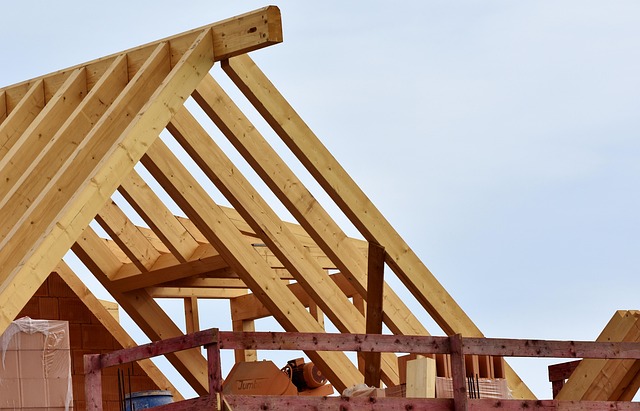Low slope roofing is ideal for commercial buildings with gentle inclines, offering cost savings, energy efficiency, and streamlined construction. These systems use advanced membrane materials and designed drainage to manage water flow, preventing damage during heavy rain. Durable materials like asphalt shingles, metal panels, or TPO membranes ensure longevity against weather exposure and UV degradation. Meticulous installation, including substrate prep, drainage systems, and secure material placement, is crucial. Regular maintenance through inspections, coatings, and cleaning prolongs the lifespan of these efficient commercial roofing solutions.
Low slope roofing systems, characterized by their shallow pitches, are a popular choice for warehouses and large commercial spaces. This article delves into the intricacies of these systems, exploring their widespread applications, benefits, and the materials used. We discuss installation processes, maintenance tips, and strategies to enhance longevity. Understanding low slope roofing offers businesses valuable insights for making informed decisions regarding their commercial structures.
- Understanding Low Slope Roofing Systems
- Common Applications in Commercial Spaces
- Advantages of Shallow-Pitch Roof Designs
- Materials Used and Their Durability
- Installation Processes and Considerations
- Maintenance and Longevity Strategies
Understanding Low Slope Roofing Systems

Low slope roofing systems are designed for structures with gentle or shallow inclines, commonly found in warehouses and large commercial buildings. Unlike steep-pitched roofs, which rely on gravity to shed water, low slope roofs use a combination of materials and engineering principles to manage drainage efficiently. These systems often feature advanced membrane materials that can withstand various environmental conditions while providing long-lasting protection against leaks and damage.
The sloped roof design in low pitch roofs is critical for proper roof drainage systems. The gentle slope allows for the collection of water, which is then directed towards downspouts or gutters. This ensures that water does not pool on the surface, reducing the risk of damage from heavy rainfall. By integrating effective roof drainage systems, these low slope roofing solutions offer a practical and durable option for commercial spaces, ensuring their structural integrity and extending their lifespan.
Common Applications in Commercial Spaces

Low slope roofing is a prevalent choice for commercial spaces, particularly warehouses and large-scale industrial buildings. Its application in these settings offers numerous advantages tailored to specific requirements. The design often incorporates flat or slightly sloped roof surfaces, differing from traditional pitched roofs. This style not only simplifies construction but also reduces the need for complex roof drainage systems, making it a cost-effective solution for large areas.
The low pitch roof is well-suited for warehouse structures due to its ability to accommodate heavy equipment and storage stacks directly on top. Moreover, the flat surface allows for efficient installation of various types of insulation, ensuring energy efficiency while managing temperature control in vast interior spaces. This versatility makes low slope roofing a prominent feature in commercial architecture, providing both functionality and aesthetic appeal in these bustling industrial environments.
Advantages of Shallow-Pitch Roof Designs

Shallow-pitched roofing systems, also known as low slope roofing, offer several advantages for warehouses and large commercial spaces. One of the primary benefits is their cost-effectiveness. Low slope roofs typically require less material and labor to install compared to sloped roof designs, making them a more affordable option. Additionally, these roofs are easier to maintain, as there’s less need for extensive cleaning and repairs.
Another advantage is improved energy efficiency. By reflecting sunlight and heat, low pitch roofs can help reduce the building’s overall energy consumption, contributing to lower cooling costs. Moreover, their smooth surface facilitates efficient roof drainage systems, ensuring water is swiftly and effectively removed from the rooftop, which can prevent water damage and extend the lifespan of the roofing materials.
Materials Used and Their Durability

The materials used in low slope roofing systems are carefully chosen to withstand the unique demands of commercial structures. These systems often feature lightweight and durable materials like asphalt shingles, metal panels, or TPO (Thermoplastic Polyolefin) membranes. Asphalt shingles, a common choice for their affordability and ease of installation, offer excellent protection against weather conditions typical in warehouses, such as rain and snow. Metal panels, known for their superior strength and longevity, are another popular option despite their higher upfront cost. They can resist intense pressure from heavy loads, making them ideal for large commercial spaces with extensive rooflines.
TPO membranes have gained popularity due to their exceptional durability and resistance to UV degradation. This material is particularly effective in regions with prolonged sunlight exposure, ensuring the low pitch roof maintains its integrity over time. Moreover, TPO membranes are seamless, reducing potential entry points for water and minimizing the risk of leaks. Effective roof drainage systems, an essential component of any low-slope roofing design, further contribute to the overall durability by managing water flow efficiently, preventing ponding, and prolonging the life of the roof.
Installation Processes and Considerations

The installation process for low slope roofing systems, common in warehouses and large commercial spaces, involves careful planning and specific techniques to ensure durability and optimal performance. Professionals begin by preparing the substrate, ensuring it’s clean, dry, and free from any debris or imperfections. A crucial step is implementing effective roof drainage systems to manage water runoff, preventing potential damage caused by pooling. This is especially important for low pitch roofs, which may not effectively shed water on their own.
Once the substrate is ready, the roofing material—often a type of membrane or single-ply sheet—is carefully unrolled and secured with specialized adhesives or mechanical fasteners. Proper sloped roof design is then achieved through a combination of these materials and precise installation techniques. The goal is to create an even surface that can withstand environmental elements while maintaining structural integrity, making it a key consideration in the low slope roofing process.
Maintenance and Longevity Strategies

Low slope roofing systems, while popular for their efficient coverage in large commercial spaces like warehouses, require specific maintenance strategies to ensure longevity. Regular inspections are crucial to identify any signs of damage or leaks early on. This includes examining the integrity of seals, flashing, and roof membranes, as well as checking for stagnant water or mold growth, which can compromise the system’s effectiveness.
Implementing proper roof drainage systems is essential for maintaining these low pitch roofs. Efficient water flow prevents ponding, which can lead to structural damage over time. Additionally, applying protective coatings or sealers can safeguard against UV rays and extreme weather conditions, prolonging the life of the roofing material. Regular cleaning and maintenance routines, coupled with timely repairs, contribute significantly to keeping these shallow-pitched roofs in optimal condition for years to come.
